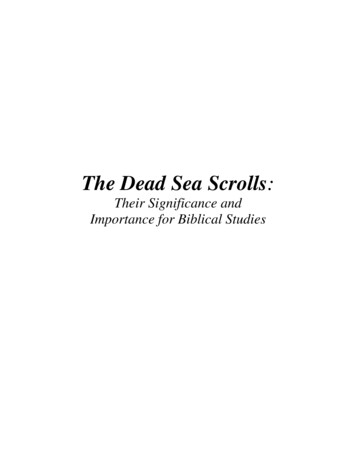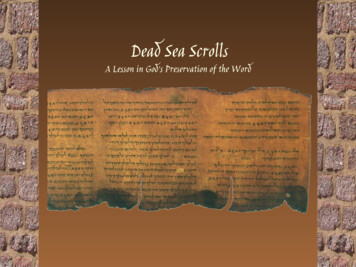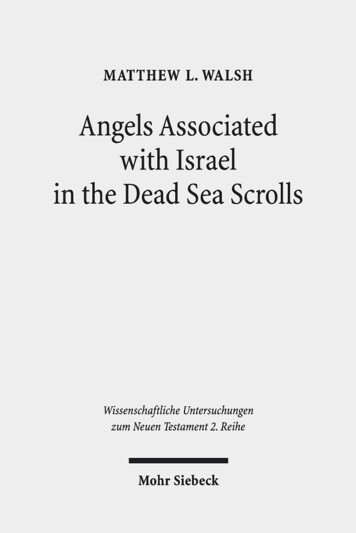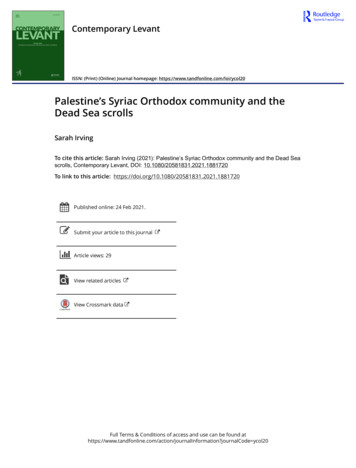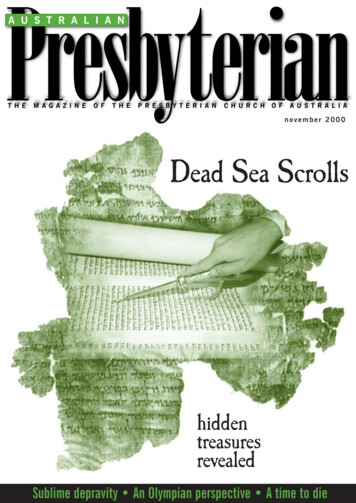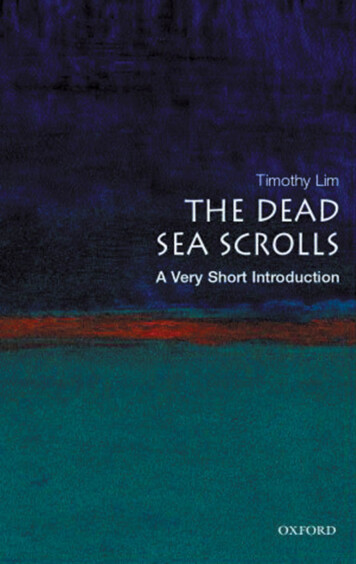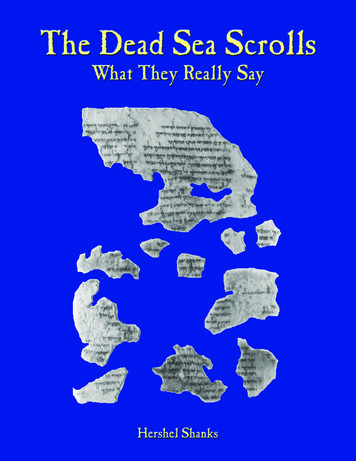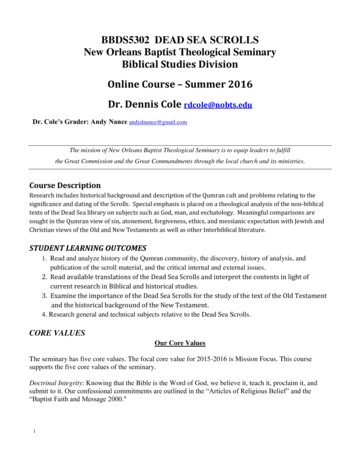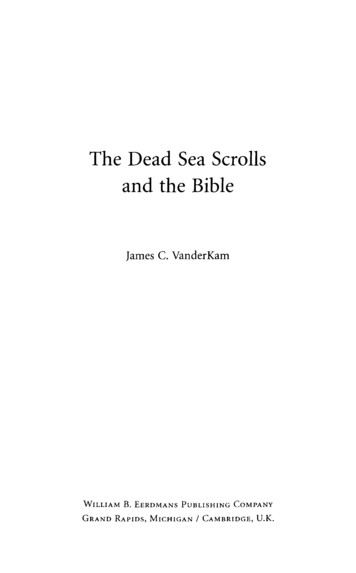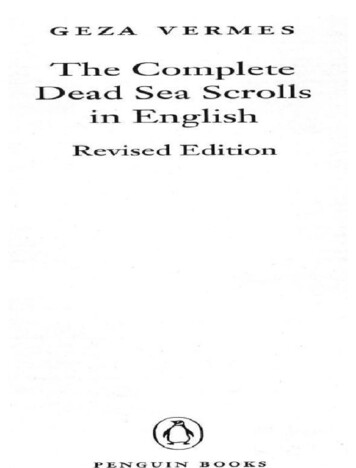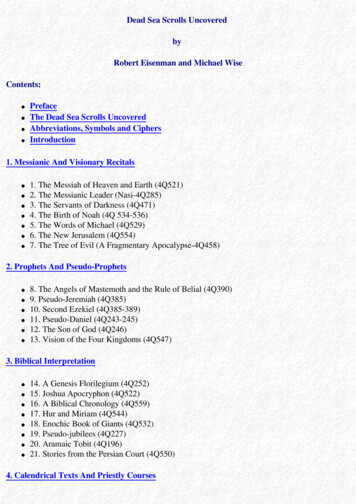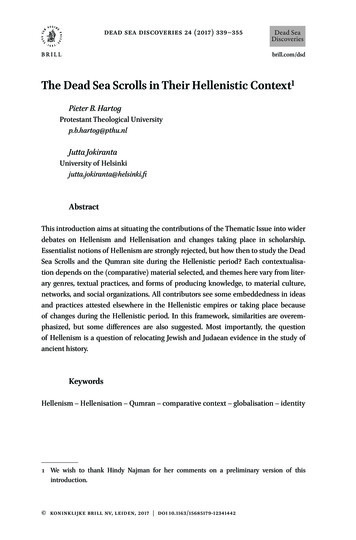
Transcription
Dead Sea Discoveries 24 (2017) 339–355brill.com/dsdThe Dead Sea Scrolls in Their Hellenistic Context1Pieter B. HartogProtestant Theological Universityp.b.hartog@pthu.nlJutta JokirantaUniversity of Helsinkijutta.jokiranta@helsinki.fiAbstractThis introduction aims at situating the contributions of the Thematic Issue into widerdebates on Hellenism and Hellenisation and changes taking place in scholarship.Essentialist notions of Hellenism are strongly rejected, but how then to study the DeadSea Scrolls and the Qumran site during the Hellenistic period? Each contextualisation depends on the (comparative) material selected, and themes here vary from literary genres, textual practices, and forms of producing knowledge, to material culture,networks, and social organizations. All contributors see some embeddedness in ideasand practices attested elsewhere in the Hellenistic empires or taking place becauseof changes during the Hellenistic period. In this framework, similarities are overemphasized, but some differences are also suggested. Most importantly, the questionof Hellenism is a question of relocating Jewish and Judaean evidence in the study ofancient history.KeywordsHellenism – Hellenisation – Qumran – comparative context – globalisation – identity1 We wish to thank Hindy Najman for her comments on a preliminary version of thisintroduction. koninklijke brill nv, leiden, 7 doi 10.1163/15685179-12341442
340Hartog and Jokiranta“Qumran and Hellenism” would have made a catchy title for this introduction.2Yet it would not have been a very suitable one, seeing that all contributors tothis volume resist or object to the dichotomy inherent in that expression. Theaim of this volume is to seek new ways to look at the Qumran scrolls and thesite of Qumran in light of their broader context within the Hellenistic andMediterranean world. On a political level, this context was determined fora large part by the rule of Greek and Roman kings and emperors and theirallies. Moreover, the authors and collectors of the Dead Sea Scrolls engagedwith and were immersed on a cultural level in what could broadly be labelled“Hellenism.”Central to the debate are definitions. How exactly should we conceive of“Hellenism” and “Qumran/the Dead Sea Scrolls”? J. G. Droysen’s pioneeringwork remains highly important, even if certain aspects of his understandingof “Hellenism” to refer both to the political institutions of Alexander and hissuccessors and to the cultural merging of Greek and Oriental (not specificallyJewish) elements have been rightly criticised. The main point of criticism wasDroysen’s overall Hegelian framework, which led him to consider Christianityas the ultimate telos of Hellenism and thus to leave Judaism on a sidetrack.3 Atthe same time, Droysen’s view on Hellenism as not a uniquely Greek culturalphenomenon, but as a process of cultural fusion has been taken up in in EliasBickerman’s and Martin Hengel’s monumental studies, in which they demonstrated the far-reaching indebtedness of Judaism in the Hellenistic and Romanperiods to Greek traditions.42 Cf. Martin Hengel, “Qumrān und der Hellenismus,” in Qumrân: Sa piété, sa théologie et sonmilieu (ed. Mathias I. Delcor; BETL 46; Gembloux: Duculot, 1978), 333–72; repr. in Judaicaet Hellenistica: Kleine Schriften I (WUNT 90; Tübingen: Mohr Siebeck, 1996), 258–94; idem,“Qumran and Hellenism,” in Religion in the Dead Sea Scrolls (ed. John J. Collins and RobertA. Kugler; SDSSRL; Grand Rapids, Mich.: Eerdmans, 2000), 46–56.3 Johann G. Droysen, Geschichte des Hellenismus, 2 vols. (Hamburg: Friedrich Perthes, 1836).On Droysen’s work and its reception see, e.g., Arnaldo Momigliano, “J. G. Droysen betweenGreeks and Jews,” History and Theory 9 (1970): 139–53; Reinhold Bichler, “Johann GustavDroysen und der Epochenbegriff des Hellenismus,” Groniek 177 (2008): 9–22; Ian S. Moyer,Egypt and the Limits of Hellenism (Cambridge: Cambridge University Press, 2011), 11–36.4 Martin Hengel, Judentum und Hellenismus: Studien zu ihrer Begegnung unter besondererBerücksichtigung Palästinas bis zur Mitte des 2. Jh. v. Chr. (Tübingen: Mohr Siebeck, 1969);ET Judaism and Hellenism: Studies in their Encounter in Palestine during the Early HellenisticPeriod, 2 vols., trans. J. Bowden (Philadelphia: Fortress, 1974); idem, “The Interpenetration ofJudaism and Hellenism in the Pre-Maccabean Period,” in The Cambridge History of Judaism,ed. W. D. Davies and Louis Finkelstein (Cambridge: Cambridge University Press, 1989),Dead Sea Discoveries 24 (2017) 339–355
The Dead Sea Scrolls In Their Hellenistic Context341Whereas Bickerman and Hengel portrayed Hellenism in terms of “Greekinfluences” on “Judaism,” more recent studies have problematised both theconcept of “Hellenistic influence” and the idea of conflict-oriented encounters“Judaism” may have had with “Hellenism.” The book of 2 Maccabees plays animportant role in these debates, as it draws an explicit distinction betweenthe rare terminology of Ἰουδαϊσμός and Ἑλληνισμός. A long-standing scholarlytradition has understood these terms to refer to “Judaism” and “Hellenism” asbounded and opposed cultural categories. Consequently, themes and topoi inancient Jewish and early Christian writings could be accorded either a “Jewish”or a “Hellenistic” background. Hengel challenged this understanding by emphasising the role of Ἰουδαϊσμός and Ἑλληνισμός within the literary context of2 Macc,5 but continued to frame his analysis in terms of “Greek” influences on“Judaism” (which some Jews resisted). Some scholars after Hengel sought toclarify terminology by distinguishing between “Hellenisation” as Greek influences on Judaism and “Hellenism” as “the distinctively classical Greek culturalambience.”6 2 Macc, on this view, would be opposed to Hellenisation, but notto Hellenism. This terminological turn remains problematic, though, as it essentially re-establishes “Hellenism” as referring to Greek culture as a boundedentity (pace Droysen).7 Such a conception of “Hellenism” (and “Judaism”) isalien both to the intentions of the author of 2 Maccabees and to the culturalcomplexity of the Hellenistic world.85678167‒228; Elias J. Bickerman, The Jews in the Greek Age (Cambridge: Harvard University Press,1988). See Jörg Frey, “ ‘Judaism’ and ‘Hellenism’: Martin Hengel’s Work in Perspective,” in JewishCultural Encounters in the Ancient Mediterranean and Near Eastern World, ed. MladenPopović, Myles Schoonover, and Marijn Vandenberghe, JSJSup 178 (Leiden: Brill, 2017), 96–118. Lee I. Levine, Judaism and Hellenism in Antiquity: Conflict or Confluence? (Peabody, MA:Hendrickson, 1998), 16. A similar problem exists with regard to “Romanisation.” See Jutta Jokiranta et al., “Changesin Research on Judaism in the Hellenistic and Early Roman Periods: An Invitation toInterdisciplinarity,” Studia Theologica (forthcoming). On 2 Maccabees see, e.g., and from different perspectives, Erich S. Gruen, Heritage andHellenism: The Reinvention of Jewish Tradition (Berkeley: University of California Press,1998), 1–40; Steve Mason, “Jews, Judaeans, Judaizing, Judaism: Problems of Categorization inAncient History,” JSJ 38 (2007): 457–512 (460–69). On cultural complexity in the Hellenisticworld see, e.g., Glen Bowersock, Hellenism in Late Antiquity: Thomas Spencer Jerome Lectures(Ann Arbor: The University of Michigan Press, 1990); Levine, Judaism and Hellenism; PieterB. Hartog, Pesher and Hypomnema: A Comparison of Two Commentary Traditions from theHellenistic-Roman Period, STDJ 121 (Leiden: Brill, 2017), chapter 1.Dead Sea Discoveries 24 (2017) 339–355
342Hartog and JokirantaMore recent studies on the connections between Jewish and Greek culturesand identities tend to adopt a more deconstructionist perspective. Emphasisingthe complexity and ambiguity of the Hellenistic world,9 scholars have increasingly come to take the adjective “Hellenistic” as a temporal designationindicating the period from Alexander’s conquests to those of the Romans rather than a definition of broad and opaque cultural processes. From this perspective, “Qumran” was undoubtedly a part of, or embedded in, “Hellenism,” in thesense that both the site and the scrolls belonged (in part) to the Hellenisticworld. More importantly, taking up social-scientific work on the constructionand upholding of identities, scholars have been keen to point out that fewaspects of the ancient world, perhaps even none, are essentially “Hellenistic”in a sense beyond that of belonging to the time-period of the rule of Alexanderand his successors. As Louise Revell wrote with regard to Roman identity and“Romanisation,” things became Roman by being perceived and presented assuch, and Roman identity was constructed and upheld by inhabitants of theRoman Empire.10 In analogy with the work of Revell and others on Roman identity, “Hellenisation” and “Hellenism” should not be treated as bounded entities,which are simply out there, but they exist only in their individual manifestations.Things may be perceived and presented as Greek, or they may have developedin the Hellenistic period, but this does not mean that they belonged to a circumscribed “Hellenistic culture.” As a result, the adoption of practices and ideaslabelled as Greek in some sources should not necessarily be conceptualised interms of Hellenistic “influence” on non-Hellenistic cultures and traditions.The terms “Qumran” and “the Dead Sea Scrolls” are not straightforward, either. The connection between the scrolls and the nearby archaeological sitehas been amply discussed. The Qumran manuscripts are now generally takenas stemming from a wide variety of backgrounds, representing a broad anddiverse collection of Jewish writings.11 What is more, the readers and collectors9 On which see, e.g., John Ma, “Paradigms and Paradoxes in the Hellenistic World,” in Studiellenistici XX, ed. Biagio Virgilio (Pisa: Fabrizio Serra, 2008), 371–85.10 Louise Revell, Roman Imperialism and Local Identities (Cambridge: Cambridge UniversityPress, 2009).11 See, e.g., Michael O. Wise, Thunder in Gemini: And Other Essays on the History, Languageand Literature of Second Temple Palestine, JSPSup 15 (Sheffield: Sheffield Academic Press,1994), 120–22; Philip S. Alexander, “Literacy among Jews in Second Temple Palestine:Reflections on the Evidence from Qumran,” in Hamlet on a Hill: Semitic and Greek StudiesPresented to Professor T. Muraoka on the Occasion of his Sixty-Fifth Birthday, ed. MartinF. J. Baasten and Wido Th. van Peursen, OLA 118 (Leuven: Peeters, 2003), 3–24 (5–7,14–15); Mladen Popović, “Qumran as Scroll Storehouse in Times of Crisis? A ComparativePerspective on Judaean Desert Manuscript Collections,” JSJ 43 (2012): 551–94; idem, “TheDead Sea Discoveries 24 (2017) 339–355
The Dead Sea Scrolls In Their Hellenistic Context343of the Qumran scrolls are increasingly considered to belong to a broad Jewishmovement spread across Hellenistic-Roman Palestine.12 The movement behind the scrolls was no isolated community on the fringes of Judaism inthe Hellenistic-Roman period. It is evident, therefore, that if the Qumran site,movement, or writings can be demonstrated to be at home in a cultural context we would label “Greek” or “Hellenistic,” this is not simply a sign that “die‘Hellenisierung’ des Judentums auch die schroffsten Gegner des griechischen Geistes nicht ausschloß”—as Hengel writes.13 Rather, it shows that theQumran movement partook actively in broader intercultural interactions inthe Hellenistic and Roman periods. The contributions in this issue of DeadSea Discoveries address and conceptualise several of these intercultural interactions and their effects.Similarities and Differences between SourcesModern scholarly attempts to contextualise the Dead Sea Scrolls and theQumran site against their Hellenistic background are partly defined by the selection of the source material included in the comparison. This selection ofsources is also itself a comparative enterprise, as it involves a broader assessment of which sources can usefully be put side by side and which questionscan be posed to them. The contributors to this volume identify similaritiesand differences at the level of particular sources, but their discussions of thesesources tend to translate into—or arise from—wider comparisons betweendifferent corpora and their presumed respective time periods, geographicalareas, intellectual discourses, languages, or the like.Benjamin Wright’s contribution starts off at a meta-level and discusseshow previous scholars have conceptualized connections between “Qumran”and “Hellenism” and why these connections have not enjoyed great popularity. Wright moves on to discuss several fundamental aspects of the Dead SeaScrolls that reflect the embeddedness of “Qumran” within “Hellenism.” He pointsto similar types of scholarly practices, discourse, and interests in the QumranAncient ‘Library’ of Qumran between Urban and Rural Culture,” in The Dead Sea Scrolls atQumran and the Concept of a Library, ed. Sidnie White Crawford and Cecilia Wassen, STDJ116 (Leiden: Brill, 2016), 155–67.12 John J. Collins, Beyond the Qumran Community: The Sectarian Movement of the Dead SeaScrolls (Grand Rapids: Eerdmans, 2010); Joan E. Taylor, The Essenes, the Scrolls, and theDead Sea (Oxford: Oxford University Press, 2012).13 Hengel, “Qumrān und der Hellenismus,” 294.Dead Sea Discoveries 24 (2017) 339–355
344Hartog and Jokirantascrolls and the works of Hellenistic scholarship. Both the Qumran Dead SeaScrolls and Hellenistic scholarship echo the appeal of bringing together collections of writings, testify to the use and development of the commentary genre,exhibit an interest in astronomy and astrology/physiognomy, and reflect anencyclopaedic perspective. For Wright these broad connections between theQumran scrolls and Hellenistic scholarship need not indicate direct historical influence; rather, they demonstrate that the writers and collectors of theQumran scrolls were deeply embedded within their wider Hellenistic context.Finally, Wright presents a set of perhaps the closest comparative material forthe Qumran scrolls: Jewish writings in Greek and invites the readers of thisvolume to imagine how exactly these sources may have been perceived by theQumran authors.14Dennis Mizzi likewise takes a wide starting point for his comparison. InMizzi’s view, Khirbet Qumran with its environs and artefacts (which includethe Qumran scrolls) should be considered in relation to other sites in thebroader Mediterranean.15 From a pan-Mediterranean point of view, Mizziargues, Qumran appears as one nod in the network of connections, and hadto be well-connected in order to sustain itself. Such a pan-Mediterranean perspective accounts better for the imported artefacts recovered from the sitethan previous frameworks which approached Qumran as a site sui generis.What is more, pan-Mediterranean comparisons should deal not only withnumbers and types of artefacts (fine ware, for example), but also raise questions concerning the uses and meanings of such artefacts in different contexts.Finally, Mizzi treats one particular case, Qumran locus L4 (previously labelledas a “scriptorium”) and compares its archaeological features to other sites inthe Hellenistic and Roman Mediterranean. This leads to a new interpretationof the multiple functions of this locus.Whereas Wright and Mizzi stress the embeddedness of Qumran within itsHellenistic context, Benedikt Eckhardt’s comparison of the “Qumran yaḥad”and Hellenistic voluntary associations brings out a prominent difference14 See also Hindy Najman, “Jewish Wisdom in the Hellenistic Period: Towards the Study of aSemantic Constellation,” in Is There a Text in This Cave? Studies in the Textuality of the DeadSea Scrolls in Honour of George J. Brooke, ed. Ariel Feldman, Maria Cioată, and CharlotteHempel, STDJ 119 (Leiden: Brill, 2017), 459‒72, who juxtaposes 4QInstruction and Philonictraditions to understand how Wisdom may have been perceived in the Hellenistic period.15 The concept of “the broader Mediterranean” derives from the work of Fernand Braudel,whom Mizzi quotes with agreement. See Fernand Braudel, The Mediterranean and theMediterranean World in the Age of Philip II, 2 vols. (Berkeley: University of CaliforniaPress, 1995).Dead Sea Discoveries 24 (2017) 339–355
The Dead Sea Scrolls In Their Hellenistic Context345b etween some Qumran scrolls and Hellenistic practices. Rather than continuing the more traditional comparison of terminology that the respective communities used of their membership rules and practices, Eckhardt pays attentionto the different social settings in which the yaḥad and Hellenistic associationsoperated. Eckhardt shows that “multitemplism” was an integral part of GraecoRoman society and determined how Graeco-Roman associations establishedand presented themselves. The “Qumran yaḥad,” in contrast, was located inthe context of only one central sanctuary in Jerusalem. Eckhardt argues thatalthough the yaḥad of 1QS used temple language and assumed roles and functions of the temple, it could never gain a similar standing and public spacein civic society as (some of) the associations in the Hellenistic cities. He concludes that the temple-centredness of Graeco-Roman voluntary associationsaccounts for the lack of such associations in Hellenistic and Roman Palestine,where the appeal of the Jerusalem sanctuary prevented this.Hanna Tervanotko adopts a more text-focused perspective as she comparesthe literary depictions of prophetic interpreters in Jewish and Greek texts.What is more, Tervanotko points out that a study of the wider cultural background of ancient Judaism is important for understanding how things that wemight consider new in Jewish sources—mediators of the divine will are engaging with texts and interpretation of written oracles rather than proclaimingoracles themselves—have counterparts in older Greek material. She arguesthat the shift from oral to written prophecy in post-exilic Judaism, manifestin Qumran writings such as the Pesharim, can be understood in light of thedepiction of interpreters of oracles in Greek sources from the fifth century BCEonwards. Both Greek and Jewish sources portray prophetic interpreters as preserving the prophetic words through writing, by returning to earlier writtencollections for further knowledge, and by selecting the sections for divinatorypurposes. At the same time, Tervanotko points out that Greek chresmologoi, incontrast to Jewish prophets, were not portrayed as directly divinely inspired,but instead garnished their authority by attributing the sources of their interpretations to famous figures of the past.Lastly, Mladen Popović offers a broad comparison of scribal and intellectualpractices in the Qumran scrolls and the Hellenistic-Roman world. Applyinginsights from William Johnson’s work on the reading culture of Roman elites,16Popović argues that the act of reading cannot be understood in isolation ofthe production, study, and consultation of texts. In Popović’s view, such activities are based on and confirm shared norms and values held within “textual16 William A. Johnson, Readers and Reading Culture in the High Roman Empire: A Study ofElite Reading Communities (Oxford: Oxford University Press, 2010).Dead Sea Discoveries 24 (2017) 339–355
346Hartog and Jokirantacommunities,” a concept adopted from the medievalist Brian Stock.17 Moreover,Popović suggests how some anomalous features of the Qumran collection—such as the presence of excerpted texts, manuscripts with an odd combination of material, or the use of scribal markings—can be fruitfully understoodagainst the wider background of reading and textual practices in the Romanworld and its textual communities.These contributions demonstrate that similarities and differences betweentwo corpora of evidence (whether concrete and specific, or more general, at thelevel of scholarly constructions from a wide range of sources) can indeed berecognised. At the same time, the source material treated by these authors differs vastly in scope and temporal distribution. The question remains thereforewhat each of these different sources have to offer in terms of a comparativecontext for “Qumran.”Contextualising QumranTervanotko’s analysis of the Greek term chresmologos leads her to contextualise “Qumran” against the background of fifth-century BCE Greek literaturewhere this Greek term is best attested. Although she does not offer concreteclues on how the “cultural continuum [of the Qumran writers] with Greekauthors” (445) should be understood, her analysis draws on almost universally valid cross-cultural analogies of how humans are attracted by thingsancient and how writing has a lure of authenticity. Such comparison couldproceed to other (even present-day) materials where similar functions andappeals are at play.Whereas Tervanotko develops a wide temporal perspective on the Qumranscrolls, Mizzi and Wright seek to broaden our geographical conceptions of theHellenistic world. Wright emphasizes that the Hellenistic world comprised notjust Greece and Egypt, but a range of Eastern territories too. As we have seenabove, wondering how “Qumran” relates to “Hellenism” is inherently problematic if we assume that “Qumran,” like other Eastern parts of the Hellenisticworld, was “Hellenistic.” As Wright shows, a much more fruitful avenue to pursue is to wonder which cultural and religious elements can be recognised atQumran, and how these relate to cultural and religious traditions elsewhere.Mizzi adopts a similar perspective, but differs in the scope of the comparison. He argues that Qumran should be studied as a Mediterranean site—that17 Brian Stock, The Implications of Literacy: Written Language and Models of Interpretation inthe Eleventh and Twelfth Centuries (Princeton: Princeton University Press, 1983).Dead Sea Discoveries 24 (2017) 339–355
The Dead Sea Scrolls In Their Hellenistic Context347is, as one of many instantiations of a broader Mediterranean culture thatthrived in the Hellenistic and (especially) Roman periods. Whereas the notionof “Mediterranean” may be understood as referring mainly to the west (Italy,Spain, and other regions surrounding the “Great Sea”), Mizzi includes in hiscomparative material also sites to the east (such as Dura Europos, by the riverEuphrates).Eckhardt addresses the importance of the societal contexts in which socialgroups operate. He contextualises social formations within their immediatesocietal contexts in order to demonstrate that even if the social organizations(of the Qumran yaḥad and Graeco-Roman voluntary associations) had beencompletely identical, they could never have been the same since their societal contexts (Hellenistic cities and Hasmonaean Palestine) differed. Eckhardtredefines “voluntary associations” as “private associations”: these created a“fourth space” in which religious, political, and private spaces of life met andwere appropriated. Similar possibilities for creating such “fourth spaces” wereunavailable to social groups in Hasmonaean Judea.Eckhardt’s way of framing of the question (“what would the introductionof a Greek type of association mean in Hasmonaean Judea?”) may appear toplace Hasmonaean Judea outside of the “Greek world.” Whereas this may seemto bring us back to a conception of “Hellenism” as being fundamentally opposed to “Judaism,” for a classicist such as Eckhardt it seems natural to conceive of the small Hasmonaean “state” and the (expanding) areas it ruled asdistinct from the empire and Greek-governed poleis or cities with markedlyHellenistic institutions, in spite of the inclinations and power-plays continuously taking place among the Hasmonaean rulers. The significance of the environment cannot be overemphasised. Eckhardt’s article demonstrates the valueof interdisciplinary approaches, as it offers the view of an expert in Greek inscriptions and ancient history on the Qumran rule texts and their portrayals ofthe yaḥad.Popović, like Mizzi, emphasises the larger Mediterranean background ofthe Qumran Dead Sea Scrolls. In his analysis of reading culture, the specificpoint of comparison is Roman elite reading communities. It is not surprising, therefore, that Aelius Gellius’ Attic Nights and Philo of Alexandria’s worksplay a central role in Popović’s contextualisation of Qumran. Building on hisearlier work, Popović shows that the Qumran scrolls do not represent the literary heritage of a Jewish marginal movement, but testify to the type of discourses and reading practices one would expect to find amongst the Romanintellectual elite.This shows that the most suitable context to understand “Qumran” dependson the questions scholars pose to the material. Cultural continuums can beDead Sea Discoveries 24 (2017) 339–355
348Hartog and Jokirantarecognised from India to Gibraltar.18 A wide range of cultural and religioustraditions from this broad geographical area has the potential to illuminateaspects of “Qumran.” Some of these traditions (particularly Mesopotamian,Iranian, and Egyptian ones) have been given due attention either in contemporary or in previous scholarship, but others have been largely neglected. TheGreek tradition is still perhaps the most important one: it was an importantcultural factor both in the Hellenistic and in the Roman period, but its connection with the Qumran site and the Dead Sea scrolls has only recently becomea central topic.At the same time, some issues tend to remain implicit or underdeveloped.In future work on “Qumran” and “Hellenism,” it would be welcome to see moreexplicit attention to and reflection on the extent of similarities and differences/closeness and distance between comparanda (that is, to what extent one pointis closer to another in relation to a third point); the distribution and enduranceof things being compared (e.g., whether things belong to well-establishedsocietal structures or represent merely passing personal choices); the level ofcomparison (highly abstract macro-level phenomena vs. specific micro-levelactions); and lastly the meanings attached to things being compared (e.g., howidentity-defining or culturally persistent they were). Progress in this kind ofintercultural or transcultural scholarship on Qumran depends on the modelsscholars use to frame their analysis. After all, the articles in this issue demonstrate that the types of comparison scholars develop emerge not just fromtheir selection of specific source materials, but also from the models they, andother scholars before them, employ to approach “Qumran” and “Hellenism.”Models and ConceptualizationsThe contributors to this volume develop different models to account for connections and interactions of “Qumran” with its contexts. What unites thesecontributors is their justified avoidance of seeing straightforward influencesfrom “Hellenism” to “Qumran,” as if these were two distinct entities that thenclashed or merged. Wright, for instance, questions the usefulness of influencethinking and portrays Qumran as being “enmeshed” in the Mediterraneanworld. Mizzi develops the important concept of connectivity: to understand18 It is not coincidental that this is the trajectory of Apollonius according to Philostratus’Vita Apollonii (second century CE) Cf. also the Periplus of the Erythraean Sea and LionelCasson, The Periplus Maris Erythraei: Text with Introduction, Translation, and Commentary(Princeton: Princeton University Press, 1989).Dead Sea Discoveries 24 (2017) 339–355
The Dead Sea Scrolls In Their Hellenistic Context349Qumran, he argues, it is necessary to gain insight into the trade and productionroutes that spanned the Mediterranean and enabled the travel of informationas well as other forms of exchange. In the terms of this connectivity model,links between Qumran and other sites in the Mediterranean can be stronger orweaker. Eckhardt’s contribution concentrates on the impact that political realities had on the development of the Qumran yaḥad and the yaḥad’s relationship with Graeco-Roman voluntary associations. When “Qumran” becomes anintegral part of the Hellenistic world, economic and other networks play a vitalrole in defining the Mediterranean world in each setting and in enabling thetransmission of knowledge. In this way, the contributors to this issue accentuate the need to understand “Qumran” as an integral part of a wide range of economic, social, and intellectual networks that spanned the whole Hellenisticand Roman worlds, but also the need to be specific about the nature of linksin such networks.What is more, the type of comparisons scholars develop have a temporal dimension. Tervanotko conceives of centuries-earlier Greek traditions as havingoriginated from a cultural context that differs from that of the later Qumrantexts. She urges her readers to “be cautious not to force texts from one culturalcontext to answer questions about another” (443), implying that the culturalcontext of Qumran has its own original make-up. Eckhardt points out the difficulty of comparing Graeco-Roman voluntary associations to the Qumranmovement since the inscriptions attesting associations are often much laterthan the scrolls. He makes a specific attempt to find roughly contemporarysources for his particular task (comparing the place of the temple[s]). Theseefforts exemplify the need to choose one’s comparative materials critically, especially when similarities are suggested to have had some larger cultural value:the closer the comparative materials, the more interesting are the differences(but also the greater the risk of exaggerating their significance!); the furtheraway the points of comparison, the more valuable are well-defined similarities(and the greater the risk of not contextualizing these similarities properly).Revealing hidden ideological inclinations have more recently entered theagenda when using abstract labels such as “Hellenistic,” or “Roman
The Dead Sea Scrolls In Their Hellenistic Context 343 Dead Sea Discoveries 24 (2017) 339-355 of the Qumran scrolls are increasingly considered to belong to a broad Jewish movement spread across Hellenistic-Roman Palestine.12 The movement be-hind the scrolls was no isolated community on the fringes of Judaism in the Hellenistic-Roman period.
